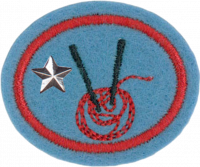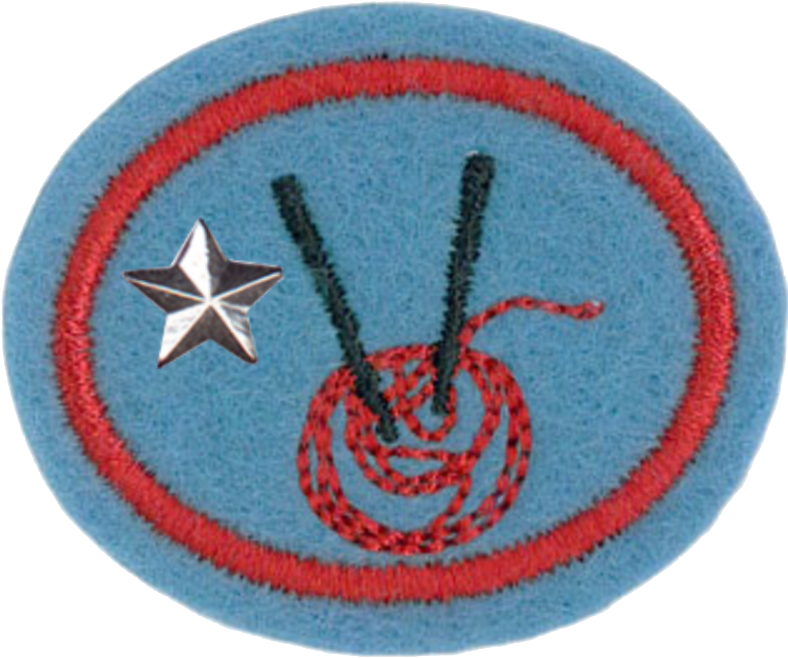Difference between revisions of "AY Honors/Knitting - Advanced/Answer Key/es"
From Pathfinder Wiki
< AY Honors | Knitting - AdvancedAY Honors/Knitting - Advanced/Answer Key/es
(Created page with "<noinclude>") |
(Created page with "</noinclude> <!-- a. Enseñarle a alguien cómo completar un proyecto de tejido básico. --> <noinclude>") |
||
| Line 16: | Line 16: | ||
{{ansreq|page={{#titleparts:{{PAGENAME}}|2|1}}|num=3}} | {{ansreq|page={{#titleparts:{{PAGENAME}}|2|1}}|num=3}} | ||
| − | <noinclude> | + | <noinclude></noinclude> |
| − | </noinclude> | + | <!-- 3. Bloquear su muestra y medir su calibre. ¿Coincide con el calibre recomendado en la etiqueta del hilo? Si no es así, ¿cómo se ajusta? --> |
| − | <!-- 3. | ||
| − | |||
<noinclude></noinclude> | <noinclude></noinclude> | ||
| Line 25: | Line 23: | ||
{{ansreq|page={{#titleparts:{{PAGENAME}}|2|1}}|num=4}} | {{ansreq|page={{#titleparts:{{PAGENAME}}|2|1}}|num=4}} | ||
| − | <noinclude> | + | <noinclude></noinclude> |
| − | </noinclude> | + | <!-- 4. ¿Por qué es importante que su calibre coincida con un patrón al hacer ropa? --> |
| − | <!-- 4. | ||
| − | |||
<noinclude></noinclude> | <noinclude></noinclude> | ||
| Line 34: | Line 30: | ||
{{ansreq|page={{#titleparts:{{PAGENAME}}|2|1}}|num=5}} | {{ansreq|page={{#titleparts:{{PAGENAME}}|2|1}}|num=5}} | ||
| − | <noinclude> | + | <noinclude></noinclude> |
| − | </noinclude> | + | <!-- 5. ¿Qué es colorwork? Hacer un artículo que use: intarsia, trenzado colorwork o Fair Isle. --> |
| − | <!-- 5. | ||
| − | |||
| − | + | {{clear}} | |
| − | |||
| − | |||
| − | |||
| − | |||
| − | + | {{clear}} | |
| − | |||
| − | |||
| − | + | {{clear}} | |
| − | |||
| − | |||
| − | + | {{clear}} | |
| − | |||
| − | |||
| − | + | {{clear}} | |
| − | |||
| − | |||
| − | + | {{clear}} | |
| − | |||
| − | |||
| − | |||
| − | + | {{clear}} | |
| − | |||
| − | |||
<noinclude></noinclude> | <noinclude></noinclude> | ||
| Line 74: | Line 51: | ||
{{ansreq|page={{#titleparts:{{PAGENAME}}|2|1}}|num=6}} | {{ansreq|page={{#titleparts:{{PAGENAME}}|2|1}}|num=6}} | ||
| − | <noinclude> | + | <noinclude></noinclude> |
| − | </noinclude> | + | <!-- 6. ¿Qué son los cables? Hacer un artículo que use cables. --> |
| − | <!-- 6. | ||
| − | |||
<noinclude></noinclude> | <noinclude></noinclude> | ||
| Line 83: | Line 58: | ||
{{ansreq|page={{#titleparts:{{PAGENAME}}|2|1}}|num=7}} | {{ansreq|page={{#titleparts:{{PAGENAME}}|2|1}}|num=7}} | ||
| − | <noinclude> | + | <noinclude></noinclude> |
| − | </noinclude> | + | <!-- 7. Tejer uno de los siguientes en redondo con agujas de doble punta o agujas circulares: mitones, calcetines, guantes sin dedos, muñequeras, gorro con disminuciones. --> |
| − | <!-- 7. | ||
| − | |||
| − | |||
| − | + | <noinclude></noinclude> | |
| − | <noinclude | ||
| − | |||
{{CloseReq}} <!-- 7 --> | {{CloseReq}} <!-- 7 --> | ||
{{ansreq|page={{#titleparts:{{PAGENAME}}|2|1}}|num=8}} | {{ansreq|page={{#titleparts:{{PAGENAME}}|2|1}}|num=8}} | ||
| − | <noinclude> | + | <noinclude></noinclude> |
| − | </noinclude> | + | <!-- 8. Tejer un suéter que le quede bien a usted o a otra persona. --> |
| − | <!-- 8. | ||
| − | |||
| − | + | <noinclude></noinclude> | |
| − | <noinclude | ||
| − | |||
{{CloseReq}} <!-- 8 --> | {{CloseReq}} <!-- 8 --> | ||
{{ansreq|page={{#titleparts:{{PAGENAME}}|2|1}}|num=9}} | {{ansreq|page={{#titleparts:{{PAGENAME}}|2|1}}|num=9}} | ||
| − | <noinclude> | + | <noinclude></noinclude> |
| − | </noinclude> | + | <!-- 9. Leer el Salmo 139 y discutir cómo se aplica al acto de tejer. --> |
| − | <!-- 9. | ||
| − | |||
| − | + | <noinclude></noinclude> | |
| − | <noinclude | ||
| − | |||
{{CloseReq}} <!-- 9 --> | {{CloseReq}} <!-- 9 --> | ||
{{ansreq|page={{#titleparts:{{PAGENAME}}|2|1}}|num=10}} | {{ansreq|page={{#titleparts:{{PAGENAME}}|2|1}}|num=10}} | ||
| − | <noinclude> | + | <noinclude></noinclude> |
| − | </noinclude> | + | <!-- 10. Realizar una de las siguientes actividades: --> |
| − | <!-- 10. | + | <noinclude></noinclude> |
| − | <noinclude | ||
| − | |||
{{ansreq|page={{#titleparts:{{PAGENAME}}|2|1}}|num=10a}} | {{ansreq|page={{#titleparts:{{PAGENAME}}|2|1}}|num=10a}} | ||
| − | <noinclude> | + | <noinclude></noinclude> |
| − | </noinclude> | + | <!-- a. Enseñarle a alguien cómo completar un proyecto de tejido básico. --> |
| − | <!-- a. | + | <noinclude></noinclude> |
| − | <noinclude | ||
| − | |||
{{CloseReq}} <!-- 10a --> | {{CloseReq}} <!-- 10a --> | ||
{{ansreq|page={{#titleparts:{{PAGENAME}}|2|1}}|num=10b}} | {{ansreq|page={{#titleparts:{{PAGENAME}}|2|1}}|num=10b}} | ||
| − | <noinclude> | + | <noinclude></noinclude> |
| − | </noinclude> | + | <!-- b. Visitar una residencia de ancianos o una persona recluida y pasar buena parte del día compartiendo y tejiendo con los demás. --> |
| − | <!-- b. | + | <noinclude></noinclude> |
| − | <noinclude | ||
| − | |||
{{CloseReq}} <!-- 10b --> | {{CloseReq}} <!-- 10b --> | ||
{{ansreq|page={{#titleparts:{{PAGENAME}}|2|1}}|num=10c}} | {{ansreq|page={{#titleparts:{{PAGENAME}}|2|1}}|num=10c}} | ||
| − | <noinclude> | + | <noinclude></noinclude> |
| − | </noinclude> | + | <!-- c. Usar el tejido para iniciar una conversación y hablar con alguien acerca del evangelio. --> |
| − | <!-- c. | + | <noinclude></noinclude> |
| − | <noinclude | ||
| − | |||
{{CloseReq}} <!-- 10c --> | {{CloseReq}} <!-- 10c --> | ||
Revision as of 20:52, 10 March 2022
Tejer - Avanzado
Nivel de destreza
3
Año
1970
Version
09.12.2025
Autoridad de aprobación
División Norteamericana
1
Tener la especialidad de Tejer.
Para consejos e instrucciones, véase Tejer.
2
Tejer un par de calcetines, guantes, o algún otro artículo, utilizando cuatro agujas y bobinas de hilo estambre.
3
Tejer una colcha o un manta bebé.
4
Tejer un suéter con mangas largas o un conjunto de bebé, gorrito y botines.
5
6
7
8
9
10
10a
10b
10c


